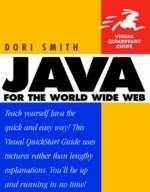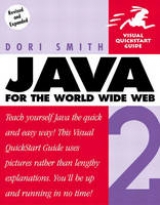
Java for the World Wide Web
Addison Wesley (Verlag)
978-0-201-35340-2 (ISBN)
- Titel ist leider vergriffen;
keine Neuauflage - Artikel merken
Visual QuickStart Guides are rapidly becoming the easiest, clearest and most sought-after titles for learning complex new Internet technologies. Even a quick glance at web design sites for the non-programmer (like C|net's Content Builder) shows that designers, graphic artists and content-creators want to use Java. The web is filled with content creators who have used a pre-built Java app., and probably not been 100% satisfied with the results.
With just enough Java to get going doing something useful, a strict focus on visual Java (meaning using Java to make interface elements for web pages), and a quality guarantee that the Java in this book will work in most - if not all - web browsers, Java for the World Wide Web:Visual QuickStart Guide is sure to be an indispensable guide to the decade's most important new programming language for the web scripter.
Dori Smith has been programming for over 20 years. As a partner in Chalcedony Consulting, she does programming, training, writing, and Web design. You can find out more about her at her personal site. Dori is also a contributing editor for NetProfessional magazine, is on their advisory board, and is a member of the Web Standards Project Steering Committee.
Introduction.
1. What Is Java?
A Little History (and even less politics). Why Learn Java? Common Java Myths. What You'll Need. Why This Book Covers Java.
2. Java Basics.
Introducing the Amazing Java Virtual Machine. Java Security. Java Files. Buzzword Bingo.
3. Using Java on Your Pages.
Placing Java Applets on Your Pages. Displaying a Message for Non-Java Browsers. Positioning Java Applets on the Page. Finding Applets on the Internet. Passing Parameters to an Applet.
4. Your First Applets.
“Hello, World.” Using Fonts. Setting the Background Color. Passing Parameters from HTML to Java. Adding Comments. Changing the Font Style. Changing the Color.
5. Strings and Things.
String Variables More about Strings. Variable Scope. String Methods. All Types of Numbers. Converting between Strings and Numbers. Converting between Types of Numbers. Converting by Casting. Arrays of Object.
6. Decisions, Decisions.
Conditionals: The If Statement. More Conditionals: If/else Statements. Around and Around with Loops. Another Loop through Loops: The While Loop. The Last Loop: The Do/while Loop. Take a Break from Loops.
7. Working with the User.
Drawing with the Mouse. Drawing in Tow Dimensions. Freehand Drawing. Capturing Keystrokes. Moving Images Around. Using Modifier Keys.
8. Building a User Interface.
Password-protecting a Page. Entering and Displaying Text. Working with Checkboxes. Using Radio Buttons. Selecting Menu Items. Using Java to Set Up the Font Menu. Using Text Areas and Buttons. Using Scrolling Lists.
9. Looking at Layout.
No Layout is FlowLayout. Using FowLayout. Giving Your Applet Some Space. Using BorderLayout. Using GridLayout. Standing Out with Insets. Using Panels to Add Components. Using CardLayout. Using GridBagLayout.
10. Making Your Pages Move.
Displaying an Image. Displaying part of an Image. Drawing a Border Around an Image. Displaying Multiple Images. Threading and Animation. Double-buffering Animation. Displaying Unlimited Images. Controlling Animation.
11. Java and JavaScript.
Checking for Java. JavaScript and Public Java Methods. Passing Information from JavaScript to Java. Passing Information from Java to JavaScript.
12. Tic-Tac-Toe.
Playing a Game of Java Tic-Tac-Toe.
A Simple Calculator.
Hierarchical Menu.
Java Hierarchical Menu.
Appendix A. Where to Learn More.
Java on the Web. Online Magazines. Integrated Development Environments (IDEs). Java Books. Newsgroups. Cross-platform Issues.
Appendix B. Reserved Words.
Java's Reserved Words.
Appendix C. The Java Object Hierarchy.
Appendix D. Differences Between JDKs 1.0 and 1.1.
The New Event Model.
Index.
| Erscheint lt. Verlag | 2.10.1998 |
|---|---|
| Verlagsort | Harlow |
| Sprache | englisch |
| Maße | 176 x 229 mm |
| Gewicht | 383 g |
| Themenwelt | Informatik ► Programmiersprachen / -werkzeuge ► Java |
| Mathematik / Informatik ► Informatik ► Web / Internet | |
| ISBN-10 | 0-201-35340-7 / 0201353407 |
| ISBN-13 | 978-0-201-35340-2 / 9780201353402 |
| Zustand | Neuware |
| Haben Sie eine Frage zum Produkt? |
aus dem Bereich



